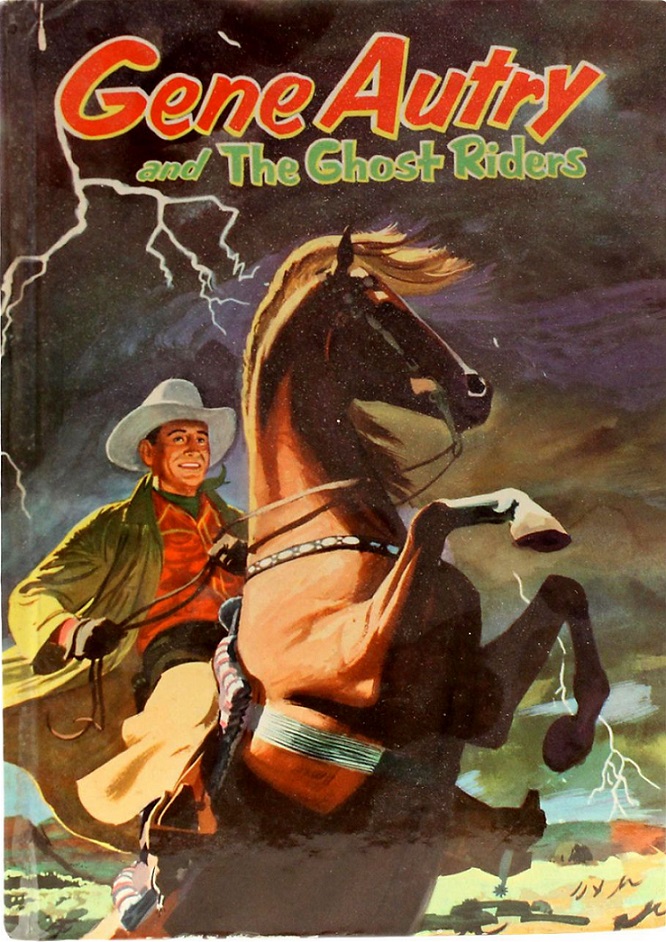Book Review: Gene Autry and the Ghost Riders by Lewis B. Patten
Gene Autry (1907-1998) was one of the world’s great cowboy singers, who did well in live performances, record sales, radio, movies and television. You may remember him from such classic songs as “Back in the Saddle Again” or “Rudolph the Red-Nosed Reindeer.” Like other stars of his time, he had his own comic books, and tie-in books for young readers like this one from 1955.

In this story, Gene Autry is reimagined as a deputy U.S. Marshal in the Arizona Territory of the old West. He and his horse Champion (who is very much his co-star) have been called in by an old friend, Victor Stone, a successful rancher near Black Mesa. Mr. Stone’s been getting anonymous threats, and things are getting tense in the nearby town of Red Feather. So tense, that Stone asks that Gene conceal his lawman status and travel under the alias of Ross Kramer.
Not that traveling incognito is without its dangers. Even before Gene gets to town, someone’s taking potshots at him. In town, “Kramer” is greeted with suspicion. Someone’s been stealing cattle from the grazing grounds atop Black Mesa, without anyone being able to find who’s doing it or where the cattle are going. The most anyone has seen is shadowy figures in the mist that disappear before you can reach them, the “ghost riders” of the title.
The only ranch that hasn’t been affected is Stone’s spread, the Two Bar. Naturally he’s the top suspect, despite a complete lack of positive evidence. This despite the fact he hasn’t left the ranch in months, penned in by the threatening letters. His daughter Gloria and Chinese cook Ching are reliable, but Gene doesn’t like the look of foreman Scar Polson. There’s something unsettlingly familiar about Polson despite Gene having never seen a man with such a burn-scarred face before, and Polson initially seemed to recognize Gene as well.
Gene starts his investigation, despite repeated head trauma, and meets the mysterious White Crow on the mesa. The Pueblo Indian knows more than he’s saying, but he knows the white man’s “justice” and is understandably wary.
Can the lawman untangle the plot and prove the true identity of the Ghost Riders before the people of Red Feather unite into a mob to destroy Victor Stone and the Two Bar?
Despite the name similarities, this novel has nothing to do with the movie Riders in the Sky (1949) in which Gene Autry sang “Ghost Riders in the Sky.” These Ghost Riders are distinctly not supernatural, and sharp readers will spot the clues along with Gene.
As a book for younger readers in the 1950s, the morality is pretty clear-cut. People are either good (if misguided) or evil. The one shade of grey is White Crow, who has a different culture which justified his “crime.” Gene understands why White Crow would consider his treatment unjust, even if it was legal.
Content note: Despite a lot of gunplay and fisticuffs, the only death takes place entirely off-page. Gene upholds the old tradition of children’s Western heroes by shooting guns out of the bad guy’s hand instead of drilling them in the heart or head. Ching appears to be a comedy ethnic stereotype at first, but later is discovered to have been deliberately putting on an act to cheer up the Stones. Scar fails to take proper care of his horse, putting that animal at risk of injury or illness (but this does not actually happen during the story. Yay!) Kids about ten and up should be able to enjoy this book no problem.
Like a lot of celebrity tie-in books from the 1940s to the 1960s, this one hasn’t been reprinted in decades. You may have trouble finding a copy in good condition. Estate sales might be your best bet. It’s a decent read, but not essential unless you’re a Gene Autry collector.

